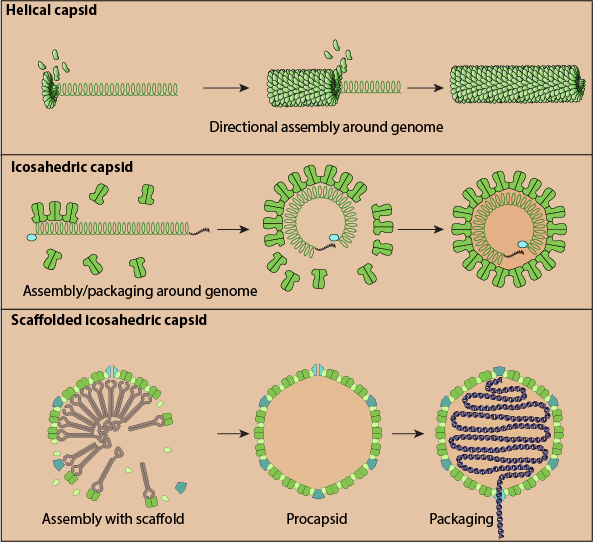Cytoplasmic capsid assembly/packaging

Capsid assembly: refers to the formation of the capsid shell.
Packaging: refers to the viral genome placement inside a capsid or an envelope.
Helical capsids are assembled around genomic RNA or DNA, and rely on self and nucleic acid interactions to assemble. Assembly and packaging are linked.
-<u>Negatives stranded RNA viruses genome is concomitantly encapsidated during replication. The packaging of these viruses occurs prior budding at the plasma membrane  .
Icosahedric capsids usually assemble by affinity around the viral genome.
Complex capsids need the help of scaffolding proteins to assemble into empty procapsids
.
Icosahedric capsids usually assemble by affinity around the viral genome.
Complex capsids need the help of scaffolding proteins to assemble into empty procapsids 
 . The scaffolding proteins are removed from the empty capsid by maturation events before packaging
. The scaffolding proteins are removed from the empty capsid by maturation events before packaging .
-<u>Nucleo-Cytoplasmic Large DNA viruses (NCLDV) contain an internal membrane, consequently they have a complex and regulated assembly mechanism. Poxviridae capsid-like protein is removed before virion maturation and serves as a scaffolding protein
.
-<u>Nucleo-Cytoplasmic Large DNA viruses (NCLDV) contain an internal membrane, consequently they have a complex and regulated assembly mechanism. Poxviridae capsid-like protein is removed before virion maturation and serves as a scaffolding protein  .
-<u>"Reoviridae":/by_species/104 and Totiviridae have their capsid assembled around messenger RNAs that are later replicated into genomic dsRNA, thereby hiding the dsRNA from cellular antiviral sensors.
.
-<u>"Reoviridae":/by_species/104 and Totiviridae have their capsid assembled around messenger RNAs that are later replicated into genomic dsRNA, thereby hiding the dsRNA from cellular antiviral sensors.

